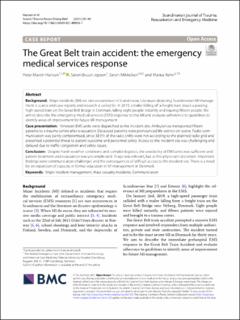| dc.contributor.author | Hansen, Peter Martin | |
| dc.contributor.author | Jepsen, Søren Bruun | |
| dc.contributor.author | Mikkelsen, Søren | |
| dc.contributor.author | Rehn, Marius | |
| dc.coverage.spatial | Denmark | en_US |
| dc.date.accessioned | 2021-10-11T09:00:34Z | |
| dc.date.available | 2021-10-11T09:00:34Z | |
| dc.date.created | 2021-10-08T09:00:13Z | |
| dc.date.issued | 2021-09 | |
| dc.identifier.citation | Hansen, P.M., Jepsen, S.B., Mikkelsen, S., Rehn, M. (2021) The Great Belt train accident: the emergency medical services response. Scandinavian Journal of Trauma, Resuscitation and Emergency Medicine, 29, 140 (2021). | en_US |
| dc.identifier.issn | 1757-7241 | |
| dc.identifier.uri | https://hdl.handle.net/11250/2788952 | |
| dc.description.abstract | Background
Major incidents (MI) are rare occurrences in Scandinavia. Literature depicting Scandinavian MI management is scarce and case reports and research is called for. In 2019, a trailer falling off a freight train struck a passing high-speed train on the Great Belt Bridge in Denmark, killing eight people instantly and injuring fifteen people. We aim to describe the emergency medical services (EMS) response to this MI and evaluate adherence to guidelines to identify areas of improvement for future MI management.
Case presentation
Nineteen EMS units were dispatched to the incident site. Ambulances transported fifteen patients to a trauma centre after evacuation. Deceased patients were pronounced life-extinct on-scene. Radio communication was partly compromised, since 38.9% of the radio shifts were not according to the planned radio grid and presented a potential threat to patient outcome and personnel safety. Access to the incident site was challenging and delayed due to traffic congestion and safety issues.
Conclusion
Despite harsh weather conditions and complex logistics, the availability of EMS units was sufficient and patient treatment and evacuation was uncomplicated. Triage was relevant, but at the physicians’ discretion. Important findings were communication challenges and the consequences of difficult access to the incident site. There is a need for an expansion of capacity in formal education in MI management in Denmark. | en_US |
| dc.language.iso | eng | en_US |
| dc.publisher | BioMed Central | en_US |
| dc.rights | Navngivelse 4.0 Internasjonal | * |
| dc.rights.uri | http://creativecommons.org/licenses/by/4.0/deed.no | * |
| dc.subject | akuttmedisin | en_US |
| dc.subject | triage | en_US |
| dc.subject | nødrespons | en_US |
| dc.subject | nødetatene | en_US |
| dc.subject | Danmark | en_US |
| dc.title | The Great Belt train accident: the emergency medical services response | en_US |
| dc.type | Peer reviewed | en_US |
| dc.type | Journal article | en_US |
| dc.description.version | publishedVersion | en_US |
| dc.rights.holder | © The Author(s) 2021 | en_US |
| dc.subject.nsi | VDP::Medisinske Fag: 700::Klinisk medisinske fag: 750::Traumatologi: 783 | en_US |
| dc.source.volume | 29 | en_US |
| dc.source.journal | Scandinavian Journal of Trauma, Resuscitation and Emergency Medicine | en_US |
| dc.source.issue | 1 | en_US |
| dc.identifier.doi | 10.1186/s13049-021-00954-7 | |
| dc.identifier.cristin | 1944343 | |
| dc.source.articlenumber | 140 (2021) | en_US |
| cristin.ispublished | true | |
| cristin.fulltext | original | |
| cristin.qualitycode | 1 | |

